Why cucumbers turn yellow and dry leaves (including around the edges): reasons and what to do
Every gardener in one way or another is faced with such a problem as yellowing of the leaves of cucumbers, and it does not matter where you grow cucumbers - in the open field, in a greenhouse or on the windowsill... In some cases, only part of the leaf turns yellow and dries, peculiar spots or yellow streaks appear, in others, the leaves turn yellow only at the edges (i.e. a yellow border forms on the leaves), and often the leaf completely turns yellow and dries up.
Next, we will analyze the main reasons why the leaves of cucumbers turn yellow, how this can be caused, and also what needs to be done so that the plant quickly recovers, continues to actively grow and bear fruit.
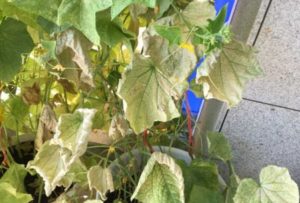
Content
- 1 Why do cucumber leaves turn yellow in the greenhouse, on the windowsill and in the open field: reasons
- 2 Yellowing of cucumber leaves due to improper care
- 3 Lack of nutrition (macro- and microelements)
- 4 Diseases that cause yellowing of leaves in cucumbers
- 5 Cucumber pests that cause yellowing of leaves
Why do cucumber leaves turn yellow in the greenhouse, on the windowsill and in the open field: reasons
Leaves are an indicator of plant health, and any change in their color indicates problems with the development of cucumbers.
Important! We immediately exclude yellowing and drying of the leaves due to their natural aging, which occurs at the end of the growing season of the plant.
Conditionally, the reasons for the yellowing of cucumber leaves can be divided into the following:
- improper care, especially lack of nutrition (certain macro- and micronutrients);
- illness;
- pests.
Now let's talk about each of the reasons, as well as what needs to be done in specific cases.
Advice! The main thing is to notice the first signs in time. Then the cause of yellowing of cucumber leaves can be easily dealt with!
Yellowing of cucumber leaves due to improper care
The most common reason for the yellowing of the leaves is non-compliance with the rules for caring for cucumbers. Let's take a look at the most popular ones below.
By the way! Due to the violation of optimal growing conditions, in addition to yellowing of the leaves, they can very often ovaries fall off and turn yellow (future cucumbers).
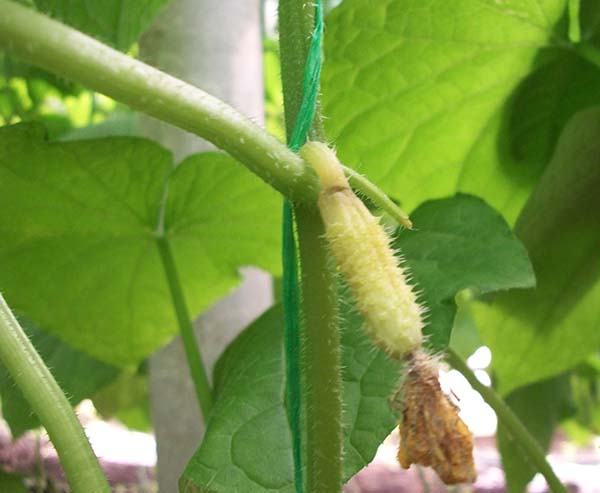
Watering and humidity
If watering cucumbers will be very rare and / or scarce, then the aerial part of the plant (leaves) will begin to wither, turn yellow and dry, and the fruits will deform.
Watering cucumbers cold water - one of the very common causes of plant oppression.
On the contrary, excessive soil moisture can damage the roots, reduce their ability to absorb nutrients from the soil, chlorosis of leaves, reduced growth energy and plant wilting.
Advice! About, how much and how often to water cucumbers in the greenhouse and open field, read in this article.
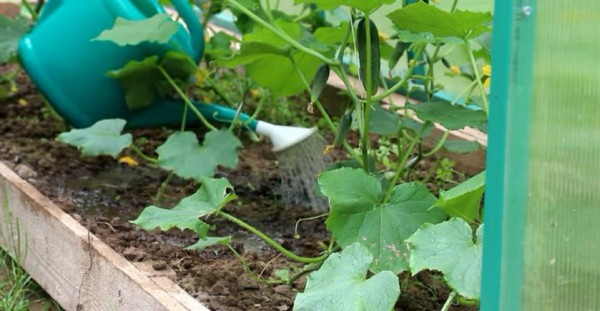
Cold or too hot weather
But, for example, too high temperatures (over +35) can call withering plants and marginal leaf necrosis.
Sunburn or lack of light
Sunburn is one of the popular causes of yellow leaves. Most often this happens due to improper watering, namely, you watered, more precisely waited out cucumbers in the afternoon, wherein large drops of water hit the leaves, as a result, they formed yellow burn spots.
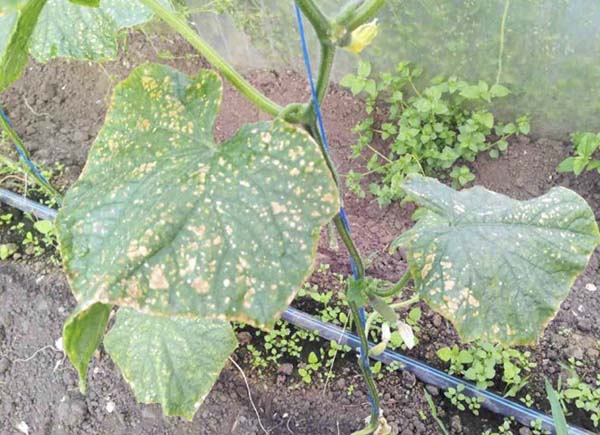
Advice! The site has material about when and how to properly water cucumbers in a greenhouse and open field.
because of lack of good lighting, so to speak, a lack of solar energy, the inhibition of the processes of photosynthesis in the leaf system of the plant will surely begin and the leaves of cucumbers will turn yellow (become pale).
therefore do not rush to plant early seedlings (especially in the greenhouse) when the daylight hours are not yet very long, and over-thicken the planting. But it is highly desirable to conduct pinching and pinching cucumber lashes!
Note! Due to too dense planting, the bushes begin to shade each other, air circulation is disrupted, and its humidity rises. In such conditions fungal diseases develop very well, which also cause yellowing of the leaves (more on this later, in a separate paragraph).
Lack of nutrition (macro- and microelements)
First of all, in order to prevent starvation of the plant, which may be accompanied by yellowing of the foliage due to the lack of certain macro- and microelements, cucumbers should be given balanced diet, and control soil acidity.
The fact is that:
- both excessive acidity of the soil, and low (excessively alkaline), is often the reason for the lack of macro- or microelements;
Advice! The site contains detailed materials about how to determine the acidity of the soil and change (decrease or increase).
- in addition, excessive or unbalanced fertilization can also lead to the fact that some macro- and micronutrients become inaccessible to plants.
Advice! To quickly make up for the lack of any battery, it is necessary to quickly carry out foliar feeding (spraying) of a plant on its leaves.
Moreover, in case of a lack of trace elements, it is better to do complex feeding, for example, with fertilizer Humate +7 or similar (which contains all the main trace elements).
Lack of nitrogen
With a lack of nitrogen nutrition, cucumbers slow down in growth, a general yellowing of plants occurs, starting with the oldest lower leaves. As a result, the cotyledons and old leaves die off, and the young leaves stop growing.
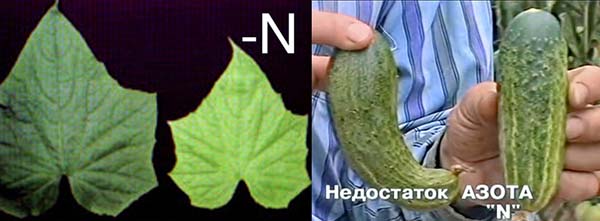
Also, the lack of nitrogen negatively affects the fruits, which decrease in diameter, and their top (the place of flower attachment) sharpens.
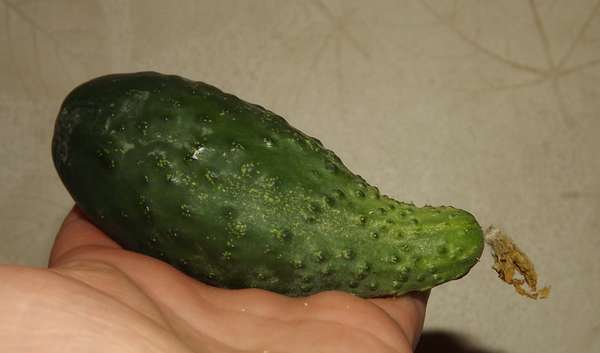
What to do?
Of course, execute top dressing nitrogen fertilizer. If you are already using fertilizer, it is recommended to increase its concentration or frequency of application. For this, for example, fit ammonium nitrate, urea (carbamide), green manure, mullein or chicken manure solution.
Lack of potassium
If the leaves of cucumbers turn yellow at the edges (in the center they remain green), i.e. you see the characteristic yellow border (marginal chlorosis), and, as a rule, it (border) is first formed on old lower leaves, then all this speaks of the explicit lack of potassium.
Wherein young leaves become reduced sizeshave dull color and take a bowl shape.
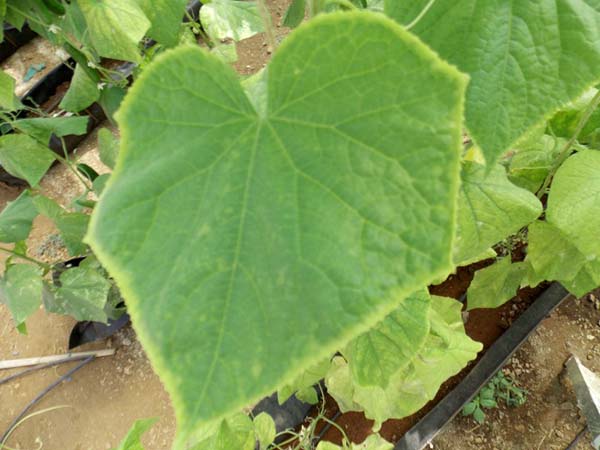
By the way! Together with the appearance of a yellow border on the leaves of cucumbers, a lack of potassium is also the reason twisting the zelents themselves, namely the narrowing fruits at the base (at the point of attachment of the stalk), as a result of which they become club-shaped.
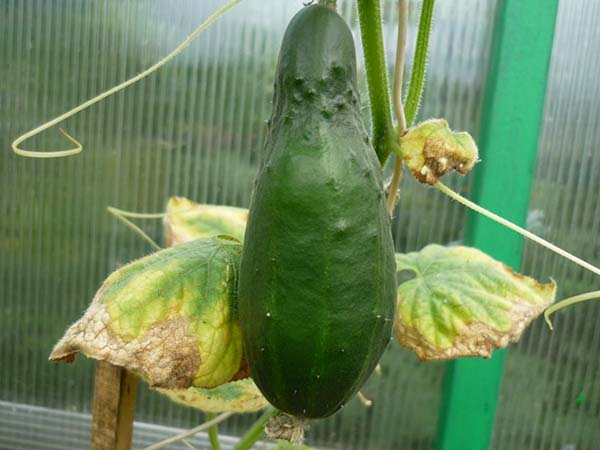
- Those. if you do not fertilize at all, then in this case you need to urgently carry out top dressing cucumbers potash fertilizer... For example, potassium nitrate, potassium sulfate (potassium sulfate), potassium monophosphate, potassium magnesium (magnesium in it) or wood ash.
Important! In no case do not use potassium chloride.
- Either you need to increase the volume (concentration) and / or frequency (not 1 time per week, but 2 times) of potassium dressings.
Note! It is very important to regularly feed the cucumbers during the fruiting period, when they especially need constant replenishment for pouring the fruits.
Advice! The site has a detailed article about how to properly feed cucumbers.
Naturally, it is worthwhile to understand that the yellow border on the leaves will not disappear anywhere, just as the cucumbers will not become straight. The main thing is that the plant will receive sufficient nutrition in the future so that all the upper and newer leaves do not turn yellow at the edges, and the fruits do not bend.
Iron (leaf chlorosis)
The lack of iron causes the appearance of interveinal chlorosis on young leaves (the plate itself becomes yellow, and the veins remain dark green), while the older leaves, on the contrary, remain green.
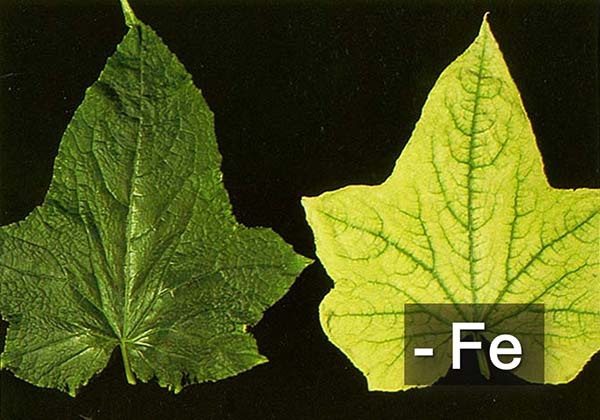
Iron deficiency is most often caused by a decreased mobility of iron in the plant. Those. it is required to make an easily and quickly assimilated (in chelated form) feeding with iron. Optimally - feed the leaves (sprinkle) the cucumbers iron chelate, for example, Ferovit.
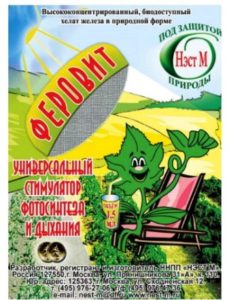
Manganese, magnesium, boron, molybdenum
- When manganese deficiency also observed interveinal chlorosis of the leaves.
Manganese deficiency can be caused by excessive liming of the soil (too low acidity - the soil is too alkaline). For example, if you feed cucumbers too often wood ash (it alkalizes the soil).
- When lack of magnesium - by the end of the growing season, interveinal chlorosis is observed on old leaves, which first appears at the edges of the leaf, and then spreads to the center. Ultimately, the entire leaf is necrotic.
As you understand, magnesium deficiency appears only in the later stages of the growing season, which means it will not lead to a significant decrease in yield.
- When boron shortage - the leaves become chlorotic, then necrotic, and the growth point dies off. The quality of the fruit decreases.
- Symptoms molybdenum deficiency are similar to the symptoms of nitrogen starvation... Plants stunted in growth, and marginal and interveinal chlorosis appears on the leaves, as a result of which they may look burnt.
Diseases that cause yellowing of leaves in cucumbers
Next, let's talk about the most common diseases of cucumbers, the signs of which are yellowing of the leaves in one form or another.
If you have determined that the leaves of the cucumbers have turned yellow or yellow spots have formed on them due to the defeat of any disease, then you have one way - start treating bushes with fungicides (means against diseases), and even better to do it in a preventive mode (i.e. even before it appears).
Advice! In general, it would be nice to find hybrids and varieties of cucumbers that are resistant to the diseases that you most often encounter. Of course, if any.
Downy mildew (downy mildew)
Perhaps the most common reason for yellowing of the leaves, more precisely, the formation of yellow spots on them in the form of a mosaic, is the defeat of the plant peronosporosis (downy mildew).
Advice! More on when and how downy mildew manifests itself, as well as measures for the control and prevention of peronosporosis on cucumbers read in this material.
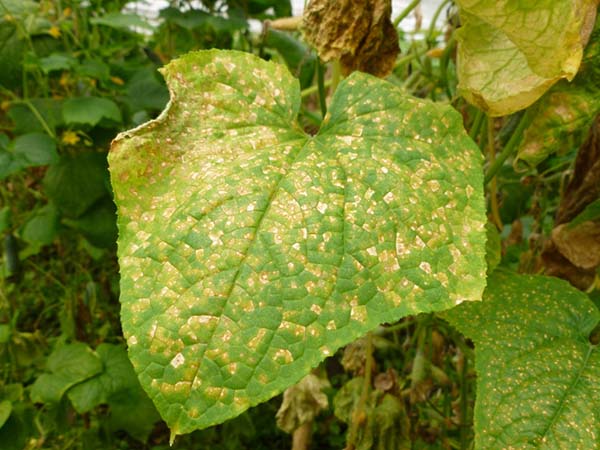
And if the leaves appeared White spots, then most likely it is powdery mildew.
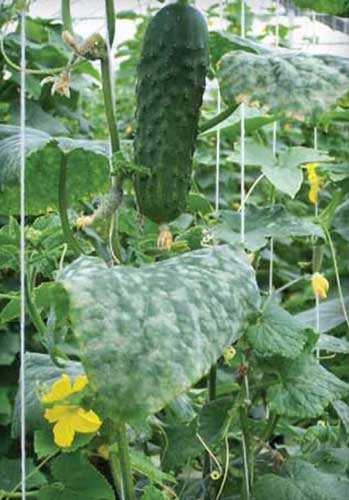
Anthracnose
If your cucumbers are sick with anthracnose, then:
- The first signs of the disease appear on the leaves in the form wet spots.
- Gradually these spots turn in rounded areas of yellowish brown color, which increase in size and turn into characteristic brown spots with a light central part. The spots are not limited to leaf veins.
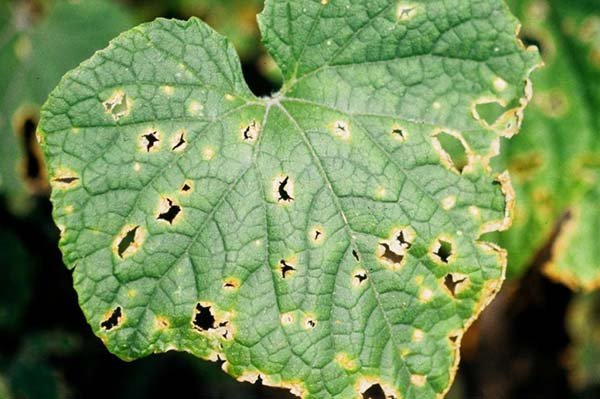
- On the affected petioles and stems, superficial elongated yellowish-brown spots are formed, which, merging, encircle the stem or petiole.
- On the affected fruits, rounded, depressed, water-saturated areas appear. These areas increase in size, and tiny black dots form in the center of them.
In humid conditions, sticky pink or orange spores of the fungus emerge from these black spots.
- If the stalks of young fruits are affected, they shrink and die. Also on young fruits, black depressed spots may form, which lead to the formation of ugly fruits.
Note! This fungal disease is treated, i.e. you need to start regular fungicide treatments.
Mosaic
- The first symptoms are found on young leaves, which curl upside down, become speckled, deformed, shriveled and shrink.
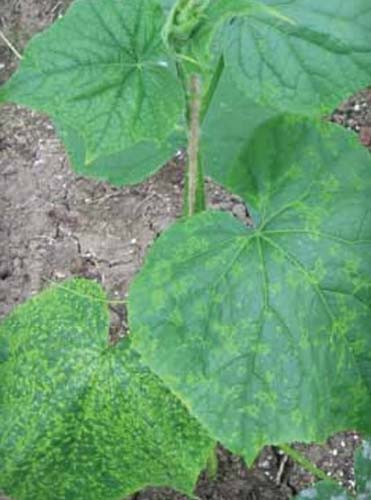
- In plants, growth retardation and short stature are observed due to shortening of internodes, leading to rosette young leaves.
- Fruits are often deformed (ugly), speckled, warty, reduced in size.
Affected fruit may look like a “pickled cucumber whitened” with very little green in color.
- If the plant is affected by mosaics in the second half of the growing season (i.e., after flowering, already during fruiting), growth retardation of the lashes may not be observed, but the fruits may develop lumpy and deformed.
From viral diseases no cure and any drugs, you can only initially plant resistant varieties and hybrids.
Fusarium rot (roots and stems) and Fusarium wilting
Another reason for wilting, yellowing and drying of cucumber leaves is such a dangerous disease as fusarium root and stem rot of cucumbers, and it not treated…
- The first symptoms of the disease appear 6-8 weeks after sowing as pale yellow spots at the base of the stem.
These lesions can grow in size and spread to the roots and stem, causing them to rot.
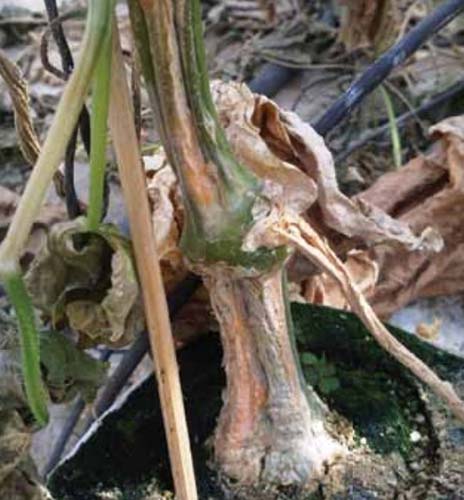
Symptoms fusarium wilting slightly different:
- Chlorosis can be observed on withered leaves, and later - necrosis of interveinal tissues.
- At the initial stage of the disease, one or more shoots wilt. And over time, the whole plant withers.
In some cases, there is a sudden death of the plant without any signs of chlorosis on the leaves.
- Infected adult plants with a high fruit load are susceptible to death.
By the way! In the heat, even healthy cucumber bushes wilt the leaves, and when the heat subsides, especially in the morning, the leaves straighten out. With fusarium at the initial stage, the same thing happens, so at first you may not even understand that the plants are sick. But over time, already in the morning, the leaves do not straighten. This disease is clearly visible here.
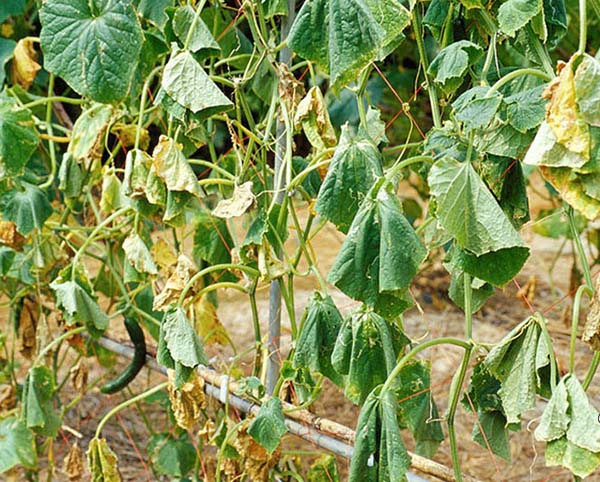
Of course, there are other diseases, including fungal, as well as bacterial and viral, but we will not list them, because there are too many of them and they are not so common.
Cucumber pests causing yellow leaves
- Melons aphid is the causative agent and carrier of many viral diseases, and also often causes leaf spot and chlorosis of the leaves, twisting of leaves, deformation and dropping of flowers.
Advice! About, how to deal with aphids on cucumbers, how to process plants, read in the next article.
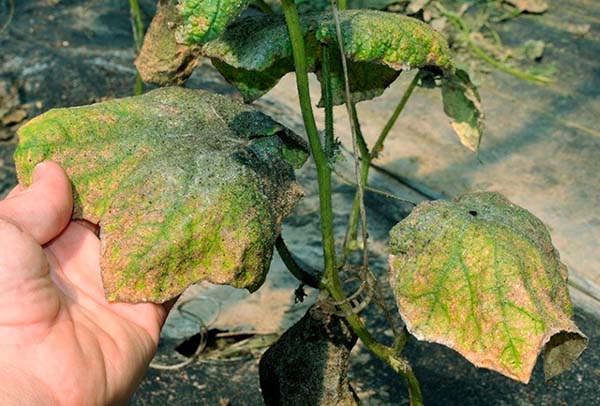
- Spider mite sucks the juices from the leaves of the plant, which is why they first turn yellow (turn brown), and then curl up, dry up and fall off.
By the way! Oh measures to combat spider mites on cucumbers detailed in this article.
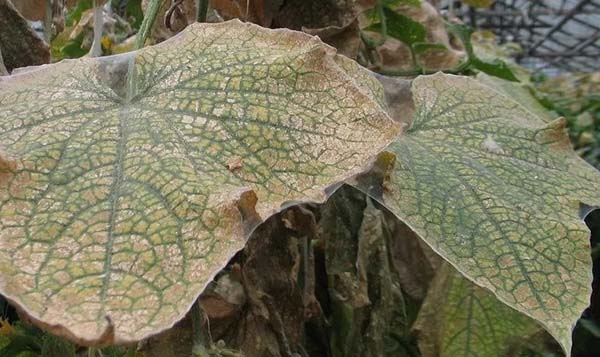
Thus, now you know why the leaves of cucumbers can turn yellow, including at the edges. Of course, it is quite difficult to immediately determine the cause of the yellowing, so you need to carefully examine the cucumber leaves, and then take the necessary measures.


THANK YOU!